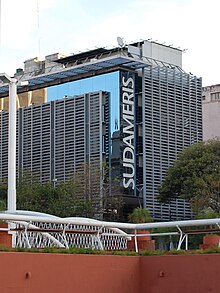Draft:Sudameris
 | Draft article not currently submitted for review.
This is a draft Articles for creation (AfC) submission. It is not currently pending review. While there are no deadlines, abandoned drafts may be deleted after six months. To edit the draft click on the "Edit" tab at the top of the window. To be accepted, a draft should:
It is strongly discouraged to write about yourself, your business or employer. If you do so, you must declare it. Where to get help
How to improve a draft
You can also browse Wikipedia:Featured articles and Wikipedia:Good articles to find examples of Wikipedia's best writing on topics similar to your proposed article. Improving your odds of a speedy review To improve your odds of a faster review, tag your draft with relevant WikiProject tags using the button below. This will let reviewers know a new draft has been submitted in their area of interest. For instance, if you wrote about a female astronomer, you would want to add the Biography, Astronomy, and Women scientists tags. Editor resources
Last edited by Monkbot (talk | contribs) 18 days ago. (Update) |

The Banque Française et Italienne pour l'Amérique du Sud (lit. 'French and Italian Bank for South America', BFIAS), abbreviated from the late 1970s as Sudameris, was a bank headquarterd in Paris that served markets in South America. Founded in 1910 and eventually disbanded in the early 2000s, it was controlled during most of that near-century by Banca Commerciale Italiana (BCI).
Overview
[edit]
BCI sponsored the creation of the BFIAS with French partners in 1910, when the new venture took over the activities of the prior Banco Commerciale Italo-Brasiliano, established in 1900 in São Paulo and controlled by BCI since 1906. The context was that France intended to develop its influence in South America, and BCI desired to expand its access to the French financial market, leveraging the rapid growth of Italian emigration to South American countries. The initial ownership structure included BCI (43.3 percent), the Banque de Paris et des Pays-Bas (BPPB, 17.6 percent), Société Générale (13.2 percent), and others. After World War I, BCI became the bank's unambiguous controlling shareholder.[1]
By 1939, the bank had branches in Brazil (São Paulo, Rio de Janeiro, Santos, Bahia, Curitiba, Porto Alegre, Recife, plus 19 agencies in smaller areas), Argentina (Buenos Aires and Rosario), Chile (Santiago and Valparaíso), Colombia (Bogotá, Barranquilla and Medellín), and Uruguay (Montevideo).[1]
During World War II, BCI and the BPPB moved some of the general management of the BFIAS from Paris to Buenos Aires, in order to allow their joint venture to claim neutrality in the conflict. These managers established a Directorate-General for South American Countries (Italian: direzione generale per i paesi sudamericani, known as DIGESUD). After France was invaded in June 1940, DIGESUD acted as head office of the South American operations.[1]
Following the liberation of France, Charles de Gaulle froze Italian assets in the country. In 1947, however, the French government waived its right to reparations for war damages, provided that BCI would reduce its stake in the bank to less than half by selling the rest to French buyers. The Banque de l'Indochine subsequently became a shareholder, but BCI was again majority shareholder by 1948. That year, the bank restarted its activity in Brazil, which it had stopped in 1941.[1]
In 1978-1979 the bank adopted the shortened name Sudameris and used it in its subsidiaries, e.g. Banco Sudameris Brasil, Banco Sudameris Paraguay, Banco Sudameris International de Panamá. Banco Sudameris reopened in Santiago (Chile) in 1979, and Banco Sudameris Colombia was created in 1982. The group, however, experienced financial stress during the 1980s.[1]
In 1994, BCI became the bank's sole shareholder. In 1995 it formed Banco Sudameris Argentina SA from what had been until then separate local branches. In 1998, Sudameris Brazil acquired Banco América do Sul, founded by Japanese immigrants in 1944. In 1999, Sudameris Peru acquired both Banco de Lima and Banco Wiese. In 2000, Sudameris Argentina absorbed Banco Caja de Ahorro.[1]
Following the merger of BCI with Banca Intesa in 2000, the new group Intesa BCI decided to leave the South American market and refocus its activity on Europe. In 2003, Sudameris Argentina was sold to Banco Patagonia; Sudameris Brazil was sold to Banco Real, later part of Santander Brasil; and Sudameris Colombia was sold to the Gilinski Group before merging in 2005 with Banco Tequendama to form GNB Sudameris. CFM Indosuez Wealth Management bought the Sudameris Monaco branch in 2004. In 2006, Scotiabank acquired Banco Wiese Sudameris, the product of merger between Banco de Lima Sudameris and Banco Wiese, and rebranded it as Scotiabank Peru. The parent entity in Paris thus became a mere asset management company, which was eventually sold to Crédit Agricole in 2006.[1]
See also
[edit]References
[edit]
